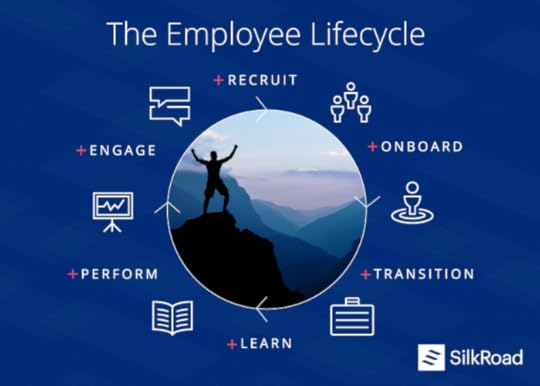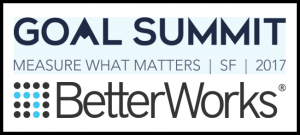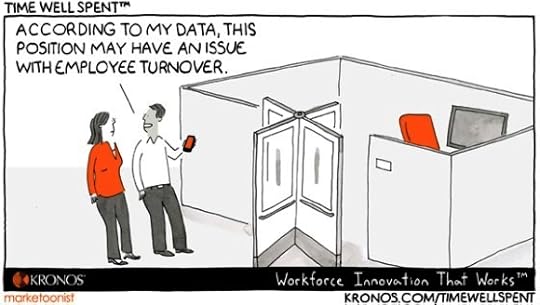Sharlyn J. Lauby's Blog, page 139
April 11, 2017
HR’s Role in Helping Organizations Accept Feedback
(Editor’s Note: Today’s post is brought to you by our friends at SilkRoad , a global leader in Talent Activation. Be sure to check out their 2017 State of Talent report , which provides an in-depth analysis of the issues that matter most to human resources.)
Feedback is about performance. The reason people give feedback is to either ask someone to improve their performance or to tell them “keep doing what you’re doing”. There’s a direct corresponding relationship between the two factors. The better the quality of input; the better the resulting performance.
So, it stands to reason that organizations need good feedback at every level. Some of the comments a company receives is from customers, and possibly, shareholders. Organizations might use outside resources to gather that feedback.
However, the third (and most important) constituent is employees. Organizational performance is driven by employees. HR plays a key role in obtaining employee feedback and communicating it to senior management.
5 Ways HR Impacts Organizational Feedback
If you think about the employee life cycle, feedback is an essential piece in each phase – from new hires to activated employees to departing employees – and every transition in between. HR plays a central role in the success of each phase. Here are some examples:
Recruiting – HR needs input about the hiring process from hiring managers and candidates. I’ve worked places where we conducted a new hire survey to get feedback from candidates about our hiring process. HR also needs to hear from management that the organization’s replacement and succession planning efforts are meeting the company’s talent needs.
Onboarding – The best way to learn is by gaining knowledge and skills when you need them. Then being able to apply those new knowledge and skills. HR and hiring managers are tasked with making sure that employees learn what they need to know at the time they need to know it. Part of the process includes following-up with employees to confirm learning is on target, on schedule, and in alignment with the organization’s needs and goals.
Performance Management – HR and department managers are responsible for setting and communicating performance standards. This takes place during the hiring process, orientation, and onboarding. Once performance standards are communicated and employees receive proper training, then employees expect regular conversations about their performance.
Employee Satisfaction – HR needs to receive feedback about compensation, benefits, rewards, and recognition. They need to know that what the company offers is internally fair and externally competitive. This has an impact on recruitment, employee engagement, and retention. Often this information is gathered during an internal employee satisfaction survey.
Offboarding – Let’s face it – employees do leave the organization and that’s not always a bad thing. Even when employees leave, HR wants to receive honest, open input about the employee experience. Departing employees can be a source of candidate and customer referrals. There’s also the possibility that they might want to boomerang back to the organization at some point.
HR touches the entire employee life cycle; therefore, they control a big piece of the company’s feedback culture. If organizations want to transform their performance to a “high-performing” culture, they will rely on HR to solicit the quality and quantity of feedback necessary to make a difference.
Developing a Feedback Culture
We all know that getting quality input isn’t as easy as it looks. We can’t simply say, “We need feedback. Let’s go get some.” The organization encourages and accepts input by building a feedback culture. And organizations that do incorporate feedback as part of their values and culture will be well positioned to maintain a competitive and sustainable business. A couple of weeks ago, SilkRoad and I presented a webinar together on “Creating a Company Culture that Embraces Feedback”. If you didn’t get a chance to hear it live, no worries – you can still listen to the recording.
There are a few things that are essential to developing a feedback culture. The obvious ones include getting buy-in from senior management and the rest of the HR team, so they will model the behavior. Plus, building a feedback model that everyone in the organization learns – hopefully during onboarding – and uses.
Feedback cultures help organizations and employees do their best workClick To Tweet
The final key piece lies with managers. They need to be prepared to reward employees for setting the example as well as coach employees who need help. They also need to be in a position to do something with the input they receive.
SilkRoad and I are taking the feedback culture conversation to the next level with a webinar next week (on April 18, 2017 at 12n Eastern) on “Coaching Managers to Welcome (and Accept) Employee Feedback”. Again, if you can’t make it – no worries – just register and you’ll receive the recording. But we hope you can join us.
I mentioned at the beginning of the year that 2017 is the “year of feedback”. Organizations and individuals need feedback to do their best work. But it must be quality feedback. HR plays a significant role in making that happen.
The post HR’s Role in Helping Organizations Accept Feedback appeared first on hr bartender.






April 9, 2017
Objectives and Key Results (OKR) – The New Goals
I think it’s pretty safe to say that I’m a goal-driven person. I like setting goals and always having something that I’m working toward. In fact, I’ve written a few posts here on HR Bartender about goals. One of my favorites is “Use Gumby to Keep Employees Focused on Goals”.
One of the things that I’ve come to realize is that setting the wrong goal can really set you back. Obviously, setting the right goals moves you forward. But, setting the wrong goals isn’t a neutral activity. If not done correctly, it can cause us to take a step backward. Not just individuals. This applies to organizations as well. So, we need to place some dedicated thought, energy, and resources toward proper goal setting.
Over the past few months, I’ve been working with my friends at BetterWorks on the topic of OKR (Objectives and Key Results). OKR is a management methodology that connects work to strategic plans in a very specific way. So, within an organization, objectives and key results connect an employee’s work to the company’s strategic plans. Here’s an example from an article I wrote over on the BetterWorks blog titled, “Why OKRs are Going Mainstream in Business”.
Objective: Improve customer service scores
Key Results:
Have 100% of employees attend “How to Deal with Difficult Customers” training by the end of Q2 2017
Track customer compliment and complaint letters (goal: 2 to 1 ratio)
Organizations that feel their goal setting processes are getting stale or that employees are just going through the motions where goal setting is concerned, might want to look at OKR as a way to breathe new life into their processes. Companies can start small by working with employees to align their personal development with the company’s OKRs. The results – both in terms of accomplishing the OKR and creating team engagement – can be huge.
If you want to learn more about OKRs and how they can help your organization, BetterWorks has a downloadable eBook on the topic. Even better, join us at BetterWorks Goal Summit in San Francisco on April 20, 2017. I’m really excited to be attending this year. One of the speakers is John Doerr, who has worked with companies like Google, Intuit, and Amazon using the OKR concept. HR Bartender readers get a FREE registration using the discount code HRBARTENDER. Hope to see you there!
The post Objectives and Key Results (OKR) – The New Goals appeared first on hr bartender.






April 7, 2017
Quick Shots for #HR and #Recruiting Pros – Military Employment Edition
According to Futurestep, only 20 percent of employers have veteran recruiting initiatives. In addition, seventy percent (70%) do not provide training to recruiters or hiring managers on veteran hiring. Veterans are a HUGE untapped source for organizational talent. So, I wanted to share with you some resources you can use to develop your military employment program.
The Society for Human Resource Management (SHRM) offers a Military Employment Resource Page. It includes a section on employer successes and best practices. You can get a little creative inspiration from others.
If you’re like me and will be attending the June SHRM Annual Conference in New Orleans, you can check out this session on How to Recruit, Onboard and Retain Veteran Talent. If you can make it to the SHRM Talent Management Conference in Chicago later this month, this session on Managing Veterans in the Workplace: A Guide for Retaining a Valuable Resource may be helpful.
In addition, the U.S. Department of Labor (USDOL) has a Veterans Hiring Toolkit. I found the section on recruiting wounded warriors and military spouses very insightful.
One of the most difficult aspects of military employment is understanding the jargon. To assist with this, your local CareerOneStop has a Civilian-to-Military Occupation Translator. They also offer information about Work Opportunity Tax Credits (WOTC).
If you’re looking for ways to sell senior management on veteran hiring, here are a few articles that might be helpful:
Why Hiring Veterans Makes Good Business Sense
How to Take a Tactical Approach to Veteran Hiring
Once your organization starts hiring veterans, it’s critical to stay on top of current employment laws that impact the military. SHRM offers a “how to” guide for developing and administering military benefits.
We keep hearing how the recruitment market is getting more challenging. Employers can’t afford to ignore this qualified groups of candidates.
Image captured by Sharlyn Lauby aboard the Queen Mary in Long Beach, CA
The post Quick Shots for #HR and #Recruiting Pros – Military Employment Edition appeared first on hr bartender.





[image error]
April 6, 2017
HR Audits: What Are They and Why Should You Conduct Them
Businesses want to know that they’re operating effectively and efficiently. So, they regularly review processes and procedures to ensure that they are. Similarly, every HR department wants to know they’re operating well. So, they do the same in the form of HR Audits.
An HR Bartender reader recently asked me about HR audits. To give us a thorough explanation, I asked Mike Haberman SHRM-SCP, co-founder of Omega HR Solutions, if he would share his expertise with us. Omega HR Solutions provides HR on demand services including compliance, audits, and training.
Mike, on a high level, what is an HR audit and why should companies consider conducting one?
[Haberman] An HR audit is a tool to help a company determine that the HR department is functioning the way it is supposed to and covering everything it is chartered to cover. It is a specific look at the current state of HR and whether its specific practices are protecting the company and providing for the best use of their ‘human’ resources.
Specifically, what is covered in an HR audit?
[Haberman] Depending on the need at the time, HR audits can cover several areas. But it does not need to always cover everything. For example, I like to think of audits in four different categories.
Organizational. The simplest audit can just be an organizational one. Is everything filed in the proper file? Often things get misfiled and as a result an important piece of paperwork may go missing. Or something will be misfiled in a folder that is not as confidential as it should be. This kind of misfiling can occur on computer files as well, not just paper.
Compliance. The second level of audit, and the one we think of most often when talking about ‘audits’, is a compliance audit. Here the policies, procedures, and practices are looked at to make sure that federal, state and local laws are being complied with properly. Are your employees properly classified under the Fair Labor Standards Act (FLSA)? Are Form I-9s complete and filed correctly? Are correct forms being used for Family and Medical Leave (FMLA)?
Functional. Rather than doing an entire compliance audit, sometimes it may be appropriate to do just a functional audit. Organizations may opt to look only at wage and hour classifications. Or focus on FMLA utilization. Benefits enrollment and proper participation levels may be an appropriate section to look for missing employees. Proper and up-to-date Occupational Safety and Health Act (OSHA) policies and recordkeeping may be appropriate. Are performance evaluations being done in a timely and effective manner?
Strategic. The highest level of audit is a strategic audit. Is HR in concert with the strategic direction of the organization? How does HR put into practice its part of the strategic plan? Are the goals appropriate?
Should internal HR do the audit or is it better to use an external consultant?
 [Haberman] The answer depends on the reason the audit was called for in the first place. If a perceived problem, such as unequal pay, prompted the call for an audit, it is best to do so through an external consultant and generally with the approval and guidance of your legal counsel. If a lawsuit were to result from a complaint, then that audit becomes ‘discoverable’ and the results could be used to prove the other side’s case.
[Haberman] The answer depends on the reason the audit was called for in the first place. If a perceived problem, such as unequal pay, prompted the call for an audit, it is best to do so through an external consultant and generally with the approval and guidance of your legal counsel. If a lawsuit were to result from a complaint, then that audit becomes ‘discoverable’ and the results could be used to prove the other side’s case.
Another reason to use an outside consultant is that the process of an audit is time consuming and frequently there will not be enough internal people to be effective in getting it done, especially if there is a short window of time to get it done.
After an audit is completed, what should a company do with the results?
[Haberman] Well, the audit was conducted to discover if there is a problem. If a problem was discovered, correct it. Unless it is one big one, such as you have been under paying women in your organization across the board, then you need to contact your legal counsel.
Often you can work with the consultant that did the audit to work through the issues with you, for a fee. Sometimes you can take the findings and develop a work list of things to get done. For example, it’s probably not an effective use of company resources to have the consultant redo your personnel files.
Are HR audits something that should be conducted on a regular basis?
[Haberman] The organizational audit is one that could be done periodically. That is just good housekeeping. Looking at Form I-9s for correctness should be done twice a year. The others should be done as the business world changes. If there has been a lot of new legislation, then an audit should be done to insure compliance. The strategic audit should be done every couple of years to insure the HR is on track with the strategic plan.
A huge thanks to Mike for taking the time to answer our questions. I loved his explanation of the four types of audits. It shows that HR audits aren’t just for start-ups or small companies. It’s something organizations need to do on a regular basis to make sure they’re being effective.
Image captured by Sharlyn Lauby at the National Atomic Testing Museum in Las Vegas, NV
The post HR Audits: What Are They and Why Should You Conduct Them appeared first on hr bartender.






April 4, 2017
Customer Service Engages Employees With Their Job
(Editor’s Note: Today’s post is brought to you by our friends at Kronos, a leading provider of workforce management and human capital management cloud solutions. To learn more about designing and managing a company culture that drives bottom line success, check out The Workforce Institute’s latest anthology, It’s All About Bob(bie): Strategies for Winning with Your Employees. Enjoy the post!)
The two top drivers of employee engagement are recognition (72 percent) and understanding how work contributes to the bottom-line (70 percent), according to a Harvard Business Review report titled “The Impact of Employee Engagement on Performance”. Using these two drivers, my takeaway is that engagement is the result of connection, meaning the employee feels a connection to the company and their work.

It recently occurred to me that customer service is a key factor in creating that connection (and subsequently, employee engagement). We know that businesses need customers and employees are the ones who deliver service to those customers. We also know that delivering excellent customer service improves the business and the bottom-line.
We know that, many times, the recognition employees receive is either directly from customers or because of an interaction they had with a customer. As a result, organizations have an opportunity to use customer service as a way for employees to understand and increase their connection to their work and the organization.
 I came to this realization during the annual Workforce Institute board meeting where Joyce Maroney, senior director of customer marketing at Kronos, was sharing some information about the rollout of Kronos’ new customer community. “Kronos launched a new customer community on the Salesforce.com platform as part of our overall transformation as a SaaS provider. The community connects customers, partners, and Kronos employees with each other, and with the content they need to derive the maximum value from their investment in Kronos technology.”
I came to this realization during the annual Workforce Institute board meeting where Joyce Maroney, senior director of customer marketing at Kronos, was sharing some information about the rollout of Kronos’ new customer community. “Kronos launched a new customer community on the Salesforce.com platform as part of our overall transformation as a SaaS provider. The community connects customers, partners, and Kronos employees with each other, and with the content they need to derive the maximum value from their investment in Kronos technology.”
During the conversation I had last month with Dave Almeda, chief people officer at Kronos, we talked about how they create an engaging candidate and employee experience. What really connected the dots for me was, after being a part of both conversations, I could see how customer service is an engagement driver. The principles of the customer community applied to both external as well as internal customers (i.e. employees).
4 Key Principles to Creating a Customer Community
Whether you’re focused on internal or external customers, there are core principles that apply in creating a successful community. Here are the four key principles to focus on:
1. Knowing the business. For employees to feel engaged with the company, they need to understand how the organization operates. In addition, employees need to understand the company’s customers: what are they looking for in a product or service, how do they use the product or service, and what do they like/dislike about the product or service the company offers.
2. Making connections. Employees need to work with others to get things done. That applies even to individual contributors. Joyce shared with us how members in the customer community are working together to help each other. “Members can pose and answer each other’s questions in the community. The member doing the asking can identify an answer as a ‘best answer’, making it that much easier for a future query to be resolved quickly.”
3. Leading the way. Employees want to control their work. That being said, they’re also open to hearing about proven best practices they can use or adapt to make their jobs easier. Joyce explained in the new Kronos customer community, members can do the same thing. “They can enter ideas for new functionality they’d like Kronos to develop and vote on these ideas. Members are providing Kronos product managers with insight about how popular a particular enhancement might be with the broader community.”
4. Empowering people. Employees do not necessarily need every question answered by a manager. They just want answers. Organizations can facilitate this by giving employees the tools and systems to solve their own problems. Examples includes collaborative technology and employee self-service. The same applies to customers. Many are very willing to search for their own answers provided the organization creates a system that will facilitate this level of service.
This video from Kronos is a great example of the connection between employee engagement and customer connection. Check out the quote from Todd in Indianapolis around the 1:00 minute mark:
In each of these principles, the employee and customer views are similar. To become engaged, you need to know the product, listen to how others successfully use the product, find proven strategies that work for you, and take advantage of the technology solutions available to you.
Customer Service Drives Engagement
Businesses know that customer service drives customer engagement. That philosophy applies both inside and outside the organization. The reverse is also true. According to an article in Harvard Business Review, companies with high levels of engagement realize higher levels of customer service.
Stepping up the company’s customer service game isn’t only a win for external customers. It can engage internal customers as well.
Image captured by Sharlyn Lauby after speaking at KronosWorks 2016 in Orlando, FL
The post Customer Service Engages Employees With Their Job appeared first on hr bartender.






April 2, 2017
7 Reasons HR Needs to Learn About Unretirement
Years ago, people just retired. They announced to their boss that they were going to retire. The company threw them a party, gave them a gold watch, and wished them well. Then, they spent their time traveling, working on their hobbies, etc. I don’t know that those days exist anymore. And if they do, it’s only for a small handful of people.
There’s an emerging conversation about unretirement. It’s the idea that you don’t have to retire. You can work on the things you want and do more of the things you enjoy. And it’s not necessarily age-based. Professionals of all ages are planning for it. Human resources needs to take note of this trend. It’s one that could benefit HR and organizations in many ways.
Recruiting: Having a contingent workforce is a must. Unretirement provides organizations will access to labor. These are individuals who don’t want to work full-time but do find occasional work a nice option. They are also someone the organization knows. So, you understand their strengths and weaknesses.
Employee Referrals: Freelancers and contractors can be a source of employee (and customer) referrals. It wouldn’t take much to revise the employee referral program to include non-employees. Referrals are still the best quality and lowest cost per hire.
Employee Engagement: While people do work to support themselves, they also work for the sense of fulfillment. In fact, many workers are staying in the workplace longer because they simply like working.
Knowledge Management: Retaining workers, even in a part-time or contingent status, allows the organization to retain knowledge. Organizational history, information about processes, and background about key clients is essential to the business.
Learning and Development: Speaking of knowledge management, organizations might find it beneficial to create short peer based training programs as a way to pass along skills and knowledge. If an employee announces their “retirement”, see if they’re willing to stop by once a month to be a lunch and learn speaker.
Performance Management: Another way that “retiring” employees can help the organization is by being a mentor or coach. Again, doesn’t need to be full-time work. Maybe they stop by once or twice a month. They have BOTH knowledge of the organization and they’re an outsider. Just be sure to give them the training to be an excellent coach and mentor.
Replacement and Succession Planning: Pew Research says that 10,000 people each day turn retirement age. For organizations concerned about a large number of employees leaving the workforce, allowing employees to openly discuss an exit strategy could be advantageous.
It’s time for organizations to have a discussion about retirement – what it is and isn’t. And how unretirement fits into the picture. I’m so convinced that unretirement is a trend that will be taking off in the near future that I’ve started another blog dedicated to the topic. It’s called “The Unretirement Project”. Mr. Bartender and I will be sharing our perspective and journey toward unretirement. I hope you’ll check it out and subscribe.
Unretirement has the ability to help organizations find and retain great talent. It has the potential to keep workers engaged and excited about their contributions. Unretirement can help organizations and individuals prosper.
The post 7 Reasons HR Needs to Learn About Unretirement appeared first on hr bartender.






March 31, 2017
Company Doors Drive Employee Turnover – Friday Distraction
Organizations have several different types of “doors”.
Some companies have configured their office space to have “no doors”. Everything is open. Employees work at communal tables. Meetings are held in little spaces that are pre-reserved. This open office concept has been seeing some backlash lately, but many companies swear by it as a way to encourage collaboration.
Then there are “open door” companies, which means that employees are encouraged to walk in, sit down, and say whatever is on their mind. Feedback is encouraged. Obviously, there’s a downside if the policy doesn’t match the practice.
Finally, some companies have the “revolving door”. Today’s Time Well Spent from our friends at Kronos explains it all too well.
The sad part about the cartoon is that often we don’t need data to see the revolving door of employee turnover. But we do need data to remove the revolving door. Think of data as the tools that will help take the door off its hinges and into the dumpster. When trying to impact employee turnover, there are three core data areas to examine.
Recruiting and onboarding practices. Organizations need to look at their hiring practices to make sure they’re selecting the right people. And review the onboarding process to ensure new employees are being set up for success. If companies hire the wrong people and don’t properly train them, employees are sure to leave.
Employee recognition and rewards. Employees want to know they’re doing a good job. And if they make an honest mistake – which does happen – that they will have an opportunity to fix it. If employees come into work every day not knowing what to expect, they will start looking for a more stable work environment.
Retention and offboarding. Companies need to understand why employees leave. Correction: companies need to understand why employees start looking for another job. A subtle but important difference. More importantly, organizations should know the reasons employees stay with the company. It’s valuable information to share during the interview process (which leads us back to #1).
We need data to remove employee revolving doors.Click To Tweet
Next time you’re walking around your office, check out the doors. Which type(s) do you have? And are you okay with what you see?
The post Company Doors Drive Employee Turnover – Friday Distraction appeared first on hr bartender.






March 30, 2017
Poor Performance Review May Stop Job Transfer – Ask #HR Bartender
I know there’s lots of talk about changing the traditional performance appraisal process. One of the things that has to be addressed is how the annual performance review impacts other things. Like employee transfers – as today’s reader note points out.
Dear Sharlyn, I’m hoping you can help me with this situation. I had my year-end performance review conversation with my manager. It seemed fine with two areas of improvement mentioned but nothing alarming per my manager. I did not receive a written appraisal at that time.
A couple weeks later, I told my manager that I was requesting a transfer to another department. After that, my manager gave me my written performance appraisal, which appeared more critical than our original conversation. Meanwhile, my transfer request was accepted and I was “unofficially” offered the position.
Now I’m concerned that my current manager gave me a more critical written performance review as a form of retaliation because I applied for a transfer. And that my new manager will read what my current manager wrote and withdraw the transfer offer.
Should I prepare a rebuttal or simply state that I disagree with the performance appraisal? I really appreciate any advice you can give. Thank you.
There are so many things we don’t know about this situation that it’s impossible to give a definitive answer. We don’t know how the company typically processes performance reviews. Or what the two areas of improvement were that the employee needed to work on. And did the employee agree that those areas needed improvement.
We also don’t know what the company policy is regarding transfers. I’ve worked at organizations where an unsatisfactory performance review could stop an employee transfer. It wasn’t because of retaliation. It was the feeling that an employee with performance issues should not be able to take those issues to a new department. It wasn’t considered fair.
For example, let’s say an employee has an attendance issue. They show up five minutes late for work every day. It might not seem like a big deal, but that five minutes impacts the team getting started on their work. The employee’s current manager has coached them on this issue. Could the current manager approve the employee’s transfer request? Absolutely. But they’d be passing along that lateness issue to the employee’s new department and manager. So, many organizations will say that an employee’s performance must be satisfactory in order for a transfer to be approved.
On the other hand, I’ve worked in organizations where as long as the receiving department was willing to accept the employee transfer knowing the performance issues existed, then it was fine. The new manager was aware that they were going to be responsible for coaching the new employee. Using the same example above, maybe the employee transfer would allow the employee to start work thirty-minutes later and fix the tardiness issue. Everyone knows it, so the transfer is approved.
Employee transfer policies are typically defined by the organization. And they should be communicated to employees so they understand the criteria and process. Employees want to know how they can create a future with the company, that includes promotions and transfers.
Performance review processes are also typically defined by the organization. They also should be communicated because employees want to know how their performance is going to be measured. It should also include what to do if an employee doesn’t agree with their review or what managers should do if they need to change a rating.
Performance reviews serve many purposes in the organization. It’s important for companies to establish what performance management means to them AND communicate it to all employees. And managers need to consistently apply it to all of their employees.
Image captured by Sharlyn Lauby while wandering the Wynwood District in Miami, FL
The post Poor Performance Review May Stop Job Transfer – Ask #HR Bartender appeared first on hr bartender.

 [image error]
[image error]



March 28, 2017
Employee Engagement: 3 Reasons You Should Be Using Survey Research
(Editor’s Note: Today’s post is brought to you by Readex Research , which provides expert survey services to help businesses understand their internal and external customers. Their services include employee experience surveys. Enjoy the post!)
Last month, Gallup released its State of the American Workplace report. It’s a long read – 200+ pages! But it’s important for two reasons. First, as much as we talk about the dynamics of employee engagement and disengagement, not much has changed. There’s still a significant percentage of the workforce that’s disengaged.
That’s an important thing to know. But the second point is that it doesn’t have to be that way. Organizations have an opportunity to find out how to engage employees. And it doesn’t involve a big, long, expensive process. In fact, it starts with something we do every day – communication.
Survey Research Versus Surveys
The definition of communication is “the imparting or exchanging of information or news.” So, one means of communication is to ask people what they think about a particular topic (i.e. survey). It’s a way for them to impart information.
However, according to Readex CEO Jack Semler, a survey might not give you the best information. Survey research will provide organizations with better insights. “There’s a distinct difference between surveys and survey research. Some would say it’s very subtle, but let me try and explain. Survey research is an ecosystem comprised of planning, creating, gathering, and then bringing understanding to data. You can gather information in many different ways, with a survey being one means. Other key components of survey research are asking questions the right way and then doing deep dives into data to provide as much clarity and life as possible. In other words, survey research is more than the act of asking questions. It’s a process based on a solid vision and plan, execution, and analysis.”
Semler’s definition reminds me of that old computer science acronym GIGO (garbage in, garbage out). If organizations do not take the time to properly plan and design their survey research project, then it could impact the information they receive. And when the goal is to act based on the data, having valid data is imperative.
Better Employee Engagement: 3 Reasons to Use Survey ResearchClick To Tweet
3 Advantages That Survey Research Can Bring to Employee Engagement Efforts
Clarity. First and foremost, survey research allows the organization to clearly hear the voice of the employee. There’s absolutely no reason to conduct survey research if you’re not interested in getting first-hand information.
Clarity is also the reason that employees are willing to participate in surveys. They want their voices heard but in a confidential way. Survey research allows organizations to clearly hear the voice of the employee using a process that ensures confidentiality. Hence, this encourages employees to truly speak their mind.
Consistency. One-on-one meetings are very effective and should be conducted on a regular basis. But when we’re talking about survey research, we need a way to quickly gather good data from a lot of people. That means using a process that will scale effectively.
Survey research can connect with employees all at once, saving time for managers, employees, and human resources. Let’s face it, no organization operates with an unlimited budget. Companies want to engage employees and utilize company resources in a responsible way.
Results. One of the biggest complaints I’ve experienced with surveys is turnaround time. Having feedback meetings with employees months after the survey doesn’t send the right message. Survey research offers a real-time reporting system, so organizations can share results in a timely fashion.
It also means that companies can act faster. Remember the goal is to impact employee engagement. So, the sooner companies have results, the sooner action plans can be developed.
Survey Research Creates Positive Impact
We all know that impacting employee engagement influences productivity, sales, and the bottom-line. But it can be hard to find a place to start. Survey research allows organizations to gather the data they need to make an impact.
If you want to learn more about how survey research can impact employee engagement, be sure to download Readex Research’s white paper on the “5 Questions to Ask Yourself Before Your Next Survey Research Project”. It’s a straight-forward read that you can socialize to the senior management team for initial feedback and discussion.
Image captured by Sharlyn Lauby at the Great Place to Work Conference in Dallas, TX
The post Employee Engagement: 3 Reasons You Should Be Using Survey Research appeared first on hr bartender.






March 26, 2017
6 Tips for Successfully Working at Home
I started my consulting firm in 2002, so I’ve been working from home for 15 years. My home office is the nicest I’ve ever had in my career.
When I was researching consulting as a profession, I asked consultants about their success strategies and biggest challenges. A couple of them talked about home offices. The first one told me as soon as I could get an office outside the home, I needed to do it because clients won’t take you seriously if you work from a home office. I didn’t follow that advice and I don’t regret it. The business world has changed a lot and most of my clients want me to visit their worksite (not the other way around.)
The second piece of advice I received was that it would take two years to learn how to effectively work at home. Yep, two years. And I must admit, it probably took me that long. Tim Sackett wrote a post on his blog titled, “Working From Home is One Big Lie” and it reminded me of the challenges people can have working at home. I know several consultants who chose to reenter the corporate world because they didn’t care for the isolationism that working from a home office can bring.
If you want to work from home, you should learn how to successfully do two things: control the distractions and embrace the freedom. On the surface, they might seem counterintuitive, but the key is to figure out the balance.
Learn How to Control the Distractions
Yes, it’s true that there are distractions in a corporate environment too. Sometimes you can tune your co-workers out by closing a door or putting on some headphones. When you work at home and you’re all by yourself…you are your own distraction. So, if you spend the afternoon playing Con Man, then you only have yourself to blame. If you want to overcome the self-imposed distractions, here are a few things to consider:
Figure out how you like to work. Self-awareness is a very powerful thing. Be honest with yourself about productivity. When are you most productive? When are you least productive?
Set up the best office space you can. Speaking of productive, your home office should allow you to be productive. Make it something that you will want to spend hours in. That includes making the space comfortable and healthy.
Designate time for home chores. Just because you’re at home, doesn’t mean that you need to do stuff around the house every day. Once you figure out your best work schedule, then you can figure out when to do the laundry, etc.
Embrace the Freedom that Comes from Working at Home
Many people want to work from home because of the flexibility it brings. And I’ll be the first to admit that it’s true – in terms of everything from time to clothing. Even when companies give employees flexible schedules, it’s not the same. But to rip-off a quote from Spiderman, “with great power comes great responsibility”. Enjoy all the benefits that working from home brings, but do it responsibly.
Practice self-discipline. If you want to visit a Starbucks to get out of the house, do it. Just remember that at some point, you must go back to work. Maybe set up a recurring appointment or reminder so you can get out.
Schedule errands and appointments during non-peak hours. A goal of working at home isn’t to work more hours. This allows you to get certain activities done faster, like doctor’s appointments and grocery shopping.
Find time to exercise and eat healthy. A huge challenge working from home is exercise. The good news is you can also visit the gym during off-peak times. And you can make healthy meals in your slow cooker while you work.
Working at home isn’t easy. There are many advantages like a lower dry cleaning bill and shorter wait times at the dentist. But there are challenges too – like exercise and self-discipline – that have to be addressed. Finding the balance that works for you takes time and honesty.
Image captured by Sharlyn Lauby while wandering her neighborhood in South Florida
The post 6 Tips for Successfully Working at Home appeared first on hr bartender.






Sharlyn J. Lauby's Blog
- Sharlyn J. Lauby's profile
- 10 followers















